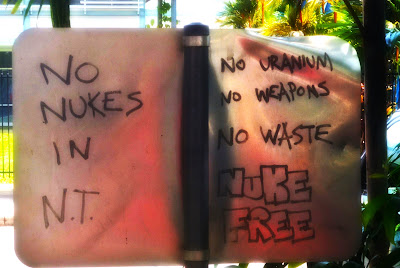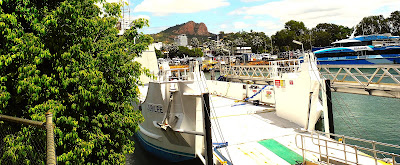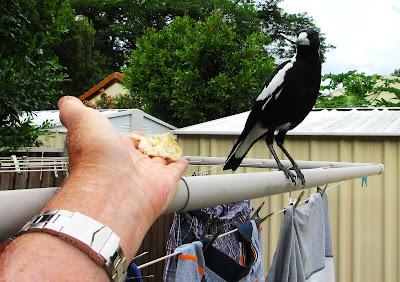Wednesday, April 30, 2025
THE TREE OF MAN
Tuesday, April 29, 2025
Monday, April 28, 2025
EXCLUSIVE : COALITION'S SECRET CRAPPY NUCLEAR POWER PLANT PLAN REVEALED
Sunday, April 27, 2025
MING THE MERCILESS BRANDISHES ROYAL WEED , MACE IN COALITION CAMPAIGN
A signed , presentation photograph, not the above, of the Australian Liberal Party founder, Sir Robert Gordon Menzies, prime minister for nearly 19 years , is for sale in a velvet lined case at $2400 by Douglas Stewart Fine Books , Melbourne.
It was presented to the Labour British Prime Minister, Harold Wilson , probably during the time Menzies was Lord Warden of the Cinque Ports and Constable of Dover Castle , from l965 to l978 , having been appointed to the post by Queen Elizabeth ll, a position he took over after the death of Winston Churchill .
Menzies's nickname , Ming, was due to the Scottish pronunciation of his name, Ming-ees. A bright newspaper columnist turned it into Ming the Merciless , after the Emperor in the Flash Gordon comic.
Naturally , an election slogan emerged which urged voters to Fling out Ming, but this did not eventuate . A staunch monarchist , Menzies once said he was British to his bootstraps, was made a Knight of the Thistle.
The photo for sale appears to have once been in the Harold and Mary Wilson Collection .
Menzies inspired cartoonist Les Tanner and artist, animator and potter Gus McLaren to make the above ceramic model of him which is in the National Portrait Gallery .
In Japan , Tanner and McLaren had both contributed to the British Commonwealth Occupation Force newspaper .
(Menzies.Election. Coalition. )
Saturday, April 26, 2025
CYCLONE TRACY CONCERTS
On January 25 , 1975, Richard Bonynge conducted a Darwin Relief Concert at the Royal Opera House, Covent Gardens, London . The idea was that of his wife, soprano Dame Joan Sutherland, who participated together with a cast of Australian, New Zealand and British operatic luminaries,of which a CD was made. Dame Joan was photographed after the concert with Prince Charles in the Crush Bar at Covent Gardens .
Darwin marked the 50th anniversary of Cyclone Tracy , Australia's most desructive natural disaster , which killed 66 , made 41,000 homeless and destroyed or severely damaged more than 70 percent of homes ,with a ceremony attended by the Govenor-General, PM Albert Albanese , the head of the Australian Defence Force .
(Cyclone. Tracy. Prince.)
Friday, April 25, 2025
BUMPER BOOK , ART AND ANTIQUE FAIR
In 1905 Nuttall went to America , became a staff artist on the New York Herald and contributed to several popular magazines.
Priced at $880 , the book is in the Douglas Stewart Fine Books list which includes a complete set of Gould's Birds of Australia,$750,000 ; a 17th century French terrestrial globe, $45,000; a circa l938 Norman Lindsay oil on canvas ,Joy of Summer , $55,000.
Also on offer will be more than 1000 high quality, hardcover monographs on Australian and International art , design, architecture, antiques and historical reference which have been acquired from several collections over the past year.
While many of these reference books are collectable in their own right, the bookshop says it simply doesn't have the space to store them: all will be marked at $10 for the duration of the fair.
(Rare. Books. Fair.)
Thursday, April 24, 2025
MANY WORDS OF WISDOM , SOME QUESTIONABLE , TO HELP YOU SAIL THROUGH LIFE TO PROMISED LAND
Due to the poor eyesight of our Shipping Reporter , he snapped up the above large book , with others, believing it might contain rollicking yarns about the sea. However, upon later perusal , he discovered it is full of the sayings of 400 prominent people , compiled by Reverend J.B.McClure (l832-1895) , of Chicago, where it was published by the Thomas W. Jackson Company .
Mind you , the waterfront roundsman said there was a strong nautical touch in the dramatic, coloured frontispiece which is of a woman , in a flowing gown , arms outstretched , looking up to the night sky , a large anchor nearby, in a rocky , seaside setting .
The title page explains the best thoughts of the writers quoted embrace beautiful maxims for the conduct of life and lucid expositions of holy writ across 528 pages, including a long list of proverbs , with illustrations from the great art galleries of the world.
A previous owner's name , Merna Hintz , caused the Shipping Reporter to do some online checking , and it seems she was Merna Anna Hintz, born Chicago , Cook County , Illinois, l942, late of Home Hill, North Queensland, who died January 2024 . Her married name Bitter
A Presbyterian, Reverend McClure, wrote several books during his life ,was the associate editor of The Interior and joint founder with Professor Daniel Swing of The Alliance and a member a publishing firm.
He did not live to finish the above book for which he had been gathering material for many years. It was passed on to Charles Carroll Albertson to turn into Pearls.
As is to be expected ,there is much about the Bible , Christ , "the superiority of the Christian faith" , all interspersed with the sayings of prominent writers, politicians and philosophers , including Shakespeare, Chaucer ,Longfellow , Plutarch .
There is a section dealing with books that quotes Bacon and a lengthy poem by Margaret E. Sangster entitled The Pleasant World of Books. Elsewhere John Wesley is quoted as saying a reading people will always be a knowing people .
Gambling is depicted as terrible as is demon grog . The " new ideas" about the rights of dumb animals , the rights of children , the rights of the " heathen myriads " must be repeated until they shall become a mode of modern thought.
There is an extensive section on the importance of the home in which there is a quote which said that if a husband spent most of the night absent from the home , by choice, not necessity, then he was not the head of the household, but only the cashier.
If a wife passed the care of the household to servants , and then spent five nights of the week at the opera or theatre, she may clothe her children with satins and laces and ribbons that would confound a French milliner , but they would only be orphans.
In dealing with America, it ran a quote saying that in its discovery, it was ordered by Providence that the two great divisions of the American hemisphere should have fallen to the two main races best fitted to "conquer and colonize them ".
The northern section consigned to the Anglo-Saxon race whose orderly, industrious habits found an ample field for development under its colder skies and more rugged soil.
The southern portion , with its rich tropical products and treasures of mineral wealth was the " bait" that attracted the enterprising Spanish . It went on to say how different might have been the result if Columbus had taken a more northerly direction and landed his band of adventurers on the shores of what is now Free America !
Words of Wisdom to the Young is the heading on a section which opens with a Disraeili pronouncement : The history of heroes is the history of youth.
The final message on the last page is to be courageous , strive with manly power against sickly phantasies ( fantasies ) and enter more hopefully into active life so that your talents may be more useful to others , and thus to yourself.
Taking all this advice aboard, the Shipping Reporter, no youngster, decided to sally forth , get a stronger pair of glasses so he better knows what the titles on books relate to and also to push aside bothersome scavengers who get in the way when he is rummaging through boxes at garage sales.
(Wisdom. America. Reporter.)
GOD HELP US !
Wednesday, April 23, 2025
ADVENTUROUS ARTIST IN TOWNSVILLE UNIVERSITY'S MANY TREASURES
A recent interesting donation to the Special Collections section of the Eddie Koiki Mabo Library, James Cook, University, Townsville, included three American books by Alice Lounsberry , illustrated by pioneering Australian botanical artist, Ellis Rowan (1848-l922).
The books are from the estate of Townsville resident Paul Tonnoir who with his wife, June, ran a fine art gallery and antiquarian book business in Magnetic House, started in l978.
He was also an approved Australian Government valuer of cultural donations to public galleries , museums , libraries and archives. His particular areas of interest were Australian paintings and prints after 1800 ; North Queensland paintings and prints after l964 ; European prints after 1700 ; antiquarian books after l500 and Persian carpets.
Of Rowan it was said she was a much-loved botanical artist , a woman who made her mark at a time when scientific illustration was a male domain.
In America, she teamed up with and travelled widely on expeditions with botanist and author Alice Lounsberry and illustrated her books about flowers and trees , published in 1899, 1900 and l901 , which were big sellers.
Lounsberry , on the board of the New York Botanic Gardens, was a fan of Rowan's. They first made contact after Lounsberry heard Rowan had collapsed due to influenza on a visit to New York and was in hospital.
Wikipedia says Alice took a handpicked box of wildflowers to the hospital, alongside a card reading “From one flower seeker to another - and an admirer of your work”. Rowan was touched by the gesture, and the two became friends, despite their twenty year age difference.
There was no apparent Ellis Rowan contribution in two other botanical related books - The Human Side of Plants and The Human Side of Trees- donated to the university and added to other Rowan material .
Author Royal Dixon , born Texas l885, was a highly regarded naturalist , animal rights activist, botanist and philosopher. He founded the first Church of Animal Rights in 1921.
The book on the right , published 1912 by Frederick A. Stokes Publishing, New York, , was dedicated to Colonel Theodore Roosevelt, described as America's foremost naturalist.
Years ago , Tonnoir provided Special Collections with a rare item related to James Morrill, who lived with Aborigines for 17 years after being shipwrecked near Townsville in 1846 , aged 22 .
It was an 1857 Book of Common Prayer , in green suede with brass edgings, presented to James Ross Morrill, his only son, by godparents Robert E. and Mary Pym, of Bowen , Queensland , where Captain Pym was the Harbour Master.
Another indication of Paul Tonnoir's great finds was the above 1866 book, now in Special Collections, presented to journalist and author Edmund James Banfield by his mother. Banfield's father owned the Ararat, Victoria, newspaper , where Edmund received early training .
In 1881 he went to North Queensland, worked on the Townsville Bulletin , moved to the then uninhabited Dunk Island with his wife , where he wrote The Confessions of a Beachcomber , published 1908, regarded as an Australian classic . His grave on Dunk is on the Queensland Heritage Register .
(University. America. Artist.)
Tuesday, April 22, 2025
HUMAN ROCK WALLABY
Monday, April 21, 2025
Sunday, April 20, 2025
FRENCH ARTIST DESIGNED FLASH AUSTRALIAN PARLIAMENT HOUSE , PROMOTED FLORA AND FAUNA
In 1888 he arranged the New South Wales court at the Melbourne Intercolonial Exhibition. At one stage he designed what was described as a " majestic " stillborn parliament house .
The Australian Dictionary of Biography states Henry , active as an artist and teacher, worked in many fields, including sculpture, modelling, terracotta work, architecture and design.
He discovered the artistic possibilities of the waratah and advocated the use of Australian colours , fauna and flora in decorative arts . In great demand in the colony, he painted many portraits , produced busts and designed the stained- glass windows of the Sydney Town Hall.
On May 25,1891, Henry returned to France after a farewell banquet. In that year he published in Paris the Legend of the Waratah and dedicated it to Fred Broomfield, prominent in Labor circles in New South Wales. He died soon after from TB contracted in New Caledonia .
Juliette Henry , who got a divorce from Lucien, died in Sydney and was buried in the Catholic section of Waverley cemetery. Before her death she had lectured on French literature in Tasmania and wrote French plays that were translated by Lady Hamilton, wife of the governor. The following tributes were published upon her death :
‘There is no personality more colourful in Sydney than Mme Juliette Henry’, whose affability and distinction were praised by The Sun of February 26, 1897. She was, wrote correspondent ‘Tasma’ in 1898, ‘one of the most large-hearted and intellectual women in Australia […] a tall, handsome, commanding woman, with a charm of manner and wide culture’ who was one of Sydney’s ‘most remarkable sisters’.
It seems she made an impression on the famous French writer and politician Victor Hugo-The Hunchback of Notre Dame and Les Miserables- when she approached him for help in her first husband's case .
(French. Australia. Art.)
Saturday, April 19, 2025
PADDINGTON BEAR DOWN UNDER UP NORTH
 |
| Clocks, a crocodile and Rubik's Cube some of the offerings. |
(Paddington. Market. Crocodile.)
.
STILL DESPERATELY SEEKING NEMO
Friday, April 18, 2025
FLY IN FLY OUT EASTER
It had a few pecks and hung around for a long time, then flew away, with a squawk , possibly someone's pet as it was so tame . Vallis pix.
Large flocks of birds have been sighted flying high over Townsville in recent days.
(Easter. Magpie. Washing.)
.


.JPG)












































